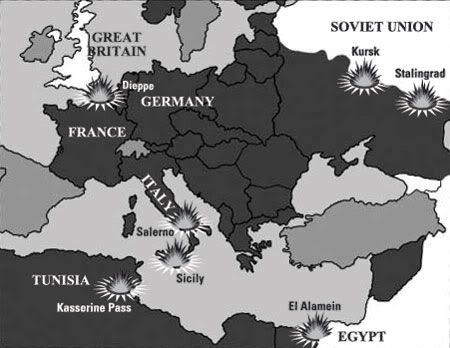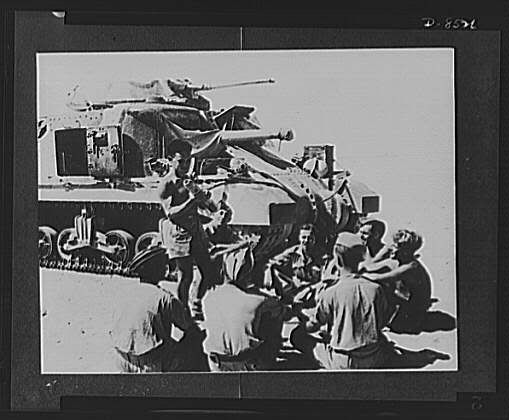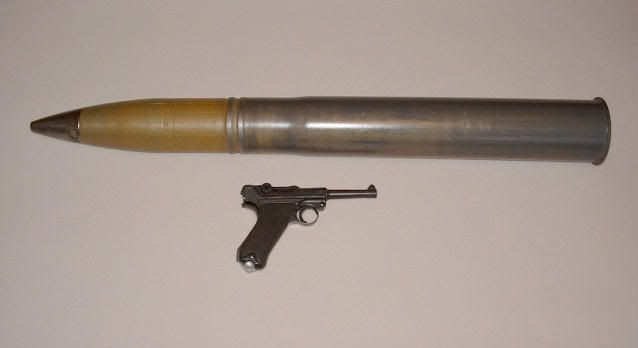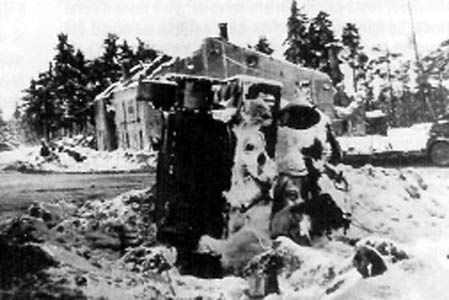This assignment was extremely difficult for me in two ways. First, I know next to nothing about photography and analyzing photographs is something completely foreign to me. I was able to overcome this obstacle by studying CDA and practicing analyzing photos in-class. My second challenge was my love of history and previous knowledge of World War II. Because I love history, it would have been very easy for me to change the essay into a history report. Also, because of my previous knowledge, it was very difficult for me to distinguish what was and was not common knowledge. For example, I had a hard time deciding if the blitzkrieg is common knowledge. I overcame the difficulty of my love and knowledge of history first by making sure everything in the essay flowed from the thesis and constantly checking to make sure I was staying on-topic. I also decided to cite every historical fact not taught in elementary school.
The largest change I made while revising was moving the paragraph with the historical context from after the thesis statement to before the thesis. My fear was that moving this paragraph would make the thesis seem irrelevant because the introduction would be too long. However, after moving the paragraph I realized this was not the case.
The second biggest change I made was taking out difficult to prove historical facts and inferences. A specific example of this is the statement, “British arrogance did not take long to show itself once again in WWII.” Since this would be difficult to know for sure, I decided the above sentence should not be in the final draft. I replaced it with the sentence “[The American] experience [with the British in WWI] would have been in the minds of American civilians and officials alike.”
Another change I made was making the paper more historically accurate. Upon doing more research on the subject, I found that some of the statements I made in the rough drafts were not entirely accurate. First, while it is true American tanks were inferior to German tanks in WWII, it turns out the M3 actually matched up relatively well at first. Thus, I removed the sentences talking about the British learning how to pilot a death trap, since the “death traps” were actually the M4s, not the M3s. This forced me to change the paragraph about the modern viewer, emphasizing that the M4 is the best known American tank of the war.
The second historical inaccuracy I found was about Pearl Harbor. Instead of defeatism, the sources I found said the main effect of the attack was not despondency, but enthusiasm and determination. Thus, I changed the argument of my essay from “reminding Americans they could win the war” to “stirring the already existing enthusiasm.”
I also took out the propaganda poster and replaced it with a picture of a tank shell compared to a pistol. I also added hyperlinks to Axis Powers and 9/11. In addition, I made minor changed to things like sentence structure, grammar, etc., but the changes listed above are the largest and most significant.
Rough Draft #1
Rough Draft #2
Statement of Purpose
Final Draft:
For the first time the United States was involved in a full scale desert war. After the sneak attack on Pearl Harbor, the United States declared war on the Axis powers and moved to invade German North Africa. It was in this environment a wartime photographer took the photo entitled British tank men study U.S. tanks between battle in Egypt. British tank crews in Egypt train for the use of tanks arriving for the U.S.A. Experts on the U.S. machine give impromptu lessons, then the men climb aboard and examine every detail themselves. A gunner giving a talk on the 75mm gun (otherwise known as British tank men).
In order to understand th e arguments made in this photograph, it is important to be familiar with its historical context. World War II began in Europe, and it was the first war to utilize the modern tank. The German military swept through Poland, the Netherlands, Belgium, and France in a very short time using a new strategy known is the blitzkrieg (lighting war), using their overpowering Panzer tanks to brush away any resistance. By 1941, this tactic had allowed Germany to annex or conquer all of continental Europe, and the Allies had no answer for the might of the Panzer. (US Memorial Holocaust Museum) This trend continued in North Africa. The allies could not match the power of the German’s tanks. The M3 Lee, the tank pictured in British tank men was supposed to change that.The M3 was the most powerful tank the Allies possessed. (militaryfactory.com) Thus, the M3 shown in British tank men would have a strong nationalistic appeal to the American viewer. After the attacks on Pearly Harbor, the American people were united to defeat their new enemies. (Robinson) British tank men was meant to keep that enthusiasm strong.
e arguments made in this photograph, it is important to be familiar with its historical context. World War II began in Europe, and it was the first war to utilize the modern tank. The German military swept through Poland, the Netherlands, Belgium, and France in a very short time using a new strategy known is the blitzkrieg (lighting war), using their overpowering Panzer tanks to brush away any resistance. By 1941, this tactic had allowed Germany to annex or conquer all of continental Europe, and the Allies had no answer for the might of the Panzer. (US Memorial Holocaust Museum) This trend continued in North Africa. The allies could not match the power of the German’s tanks. The M3 Lee, the tank pictured in British tank men was supposed to change that.The M3 was the most powerful tank the Allies possessed. (militaryfactory.com) Thus, the M3 shown in British tank men would have a strong nationalistic appeal to the American viewer. After the attacks on Pearly Harbor, the American people were united to defeat their new enemies. (Robinson) British tank men was meant to keep that enthusiasm strong.
 e arguments made in this photograph, it is important to be familiar with its historical context. World War II began in Europe, and it was the first war to utilize the modern tank. The German military swept through Poland, the Netherlands, Belgium, and France in a very short time using a new strategy known is the blitzkrieg (lighting war), using their overpowering Panzer tanks to brush away any resistance. By 1941, this tactic had allowed Germany to annex or conquer all of continental Europe, and the Allies had no answer for the might of the Panzer. (US Memorial Holocaust Museum) This trend continued in North Africa. The allies could not match the power of the German’s tanks. The M3 Lee, the tank pictured in British tank men was supposed to change that.The M3 was the most powerful tank the Allies possessed. (militaryfactory.com) Thus, the M3 shown in British tank men would have a strong nationalistic appeal to the American viewer. After the attacks on Pearly Harbor, the American people were united to defeat their new enemies. (Robinson) British tank men was meant to keep that enthusiasm strong.
e arguments made in this photograph, it is important to be familiar with its historical context. World War II began in Europe, and it was the first war to utilize the modern tank. The German military swept through Poland, the Netherlands, Belgium, and France in a very short time using a new strategy known is the blitzkrieg (lighting war), using their overpowering Panzer tanks to brush away any resistance. By 1941, this tactic had allowed Germany to annex or conquer all of continental Europe, and the Allies had no answer for the might of the Panzer. (US Memorial Holocaust Museum) This trend continued in North Africa. The allies could not match the power of the German’s tanks. The M3 Lee, the tank pictured in British tank men was supposed to change that.The M3 was the most powerful tank the Allies possessed. (militaryfactory.com) Thus, the M3 shown in British tank men would have a strong nationalistic appeal to the American viewer. After the attacks on Pearly Harbor, the American people were united to defeat their new enemies. (Robinson) British tank men was meant to keep that enthusiasm strong. British tank men was not meant to be a documentary photograph, but a propaganda photograph used to boost the spirits of American civilians. This can be seen through the pathos and logos generated from the vectors of attention, saturation, and framing, inspiring feelings of nationalism and reflecting the belief of American superiority. To the modern viewer, these same technical elements in British tank men speak of sadness and disappointment.
British tank men was not meant to be a documentary photograph, but a propaganda photograph used to boost the spirits of American civilians. This can be seen through the pathos and logos generated from the vectors of attention, saturation, and framing, inspiring feelings of nationalism and reflecting the belief of American superiority. To the modern viewer, these same technical elements in British tank men speak of sadness and disappointment. The first and most important element used by the photographer in British tank men is vectors of attention. When the viewer first sees this photograph, his eyes are immediately drawn to the tank (an M3 Lee), the focal point of the picture. By making this monument to the power of the United States the main focus of the picture, the photograph stirred the patriotism and enthusiasm of the American people. The state of the military at Pearl Harbor was no longer the case. Through the picturing of the greatest American weapon of war, Americans were inspried of their nation’s might, and encouraged to work toward victory.
After the tank, the viewer’s attention is drawn to the actual soldiers in the picture. The vectors of attention of the soldiers are extremely important to the argument this photograph was making to American civilians. The British soldiers in the picture are obviously not looking at the camera, but are instead looking toward their American instructor. By situating the American at the head of the semicircle and showing the British soldiers learning from him, the photograph is once again appealing to the nationalism of Americans. The United States and  Britain, despite being allies, had not always worked well together in war. In WWI, the British attempted to dismantle the US Army units shipped to Europe and instead use American soldiers as replacements for fallen British troops. (Hickman, Kennedy) This experience would have been in the minds of American civilians and officials alike. To combat this, the vectors of attention remind Americans and the world of American ingenuity. It is not the British who are teaching the Americans, but the Americans who are teaching the British how to fight the Germans. The logos of the vectors of attention of the British soldiers appeal to a pathos of nationalism and determination. Yet, while most of the British are looking at the American, one soldier is looking directly at the camera. He seems to be looking at the audience, reminding them the war is very real. This helps to draw the audience into the picture, and even gives the audience a feeling of sympathy for the soldiers. This would reinforce the appeals to Americans’ resolve in “getting the boys home.”
Britain, despite being allies, had not always worked well together in war. In WWI, the British attempted to dismantle the US Army units shipped to Europe and instead use American soldiers as replacements for fallen British troops. (Hickman, Kennedy) This experience would have been in the minds of American civilians and officials alike. To combat this, the vectors of attention remind Americans and the world of American ingenuity. It is not the British who are teaching the Americans, but the Americans who are teaching the British how to fight the Germans. The logos of the vectors of attention of the British soldiers appeal to a pathos of nationalism and determination. Yet, while most of the British are looking at the American, one soldier is looking directly at the camera. He seems to be looking at the audience, reminding them the war is very real. This helps to draw the audience into the picture, and even gives the audience a feeling of sympathy for the soldiers. This would reinforce the appeals to Americans’ resolve in “getting the boys home.”
 Britain, despite being allies, had not always worked well together in war. In WWI, the British attempted to dismantle the US Army units shipped to Europe and instead use American soldiers as replacements for fallen British troops. (Hickman, Kennedy) This experience would have been in the minds of American civilians and officials alike. To combat this, the vectors of attention remind Americans and the world of American ingenuity. It is not the British who are teaching the Americans, but the Americans who are teaching the British how to fight the Germans. The logos of the vectors of attention of the British soldiers appeal to a pathos of nationalism and determination. Yet, while most of the British are looking at the American, one soldier is looking directly at the camera. He seems to be looking at the audience, reminding them the war is very real. This helps to draw the audience into the picture, and even gives the audience a feeling of sympathy for the soldiers. This would reinforce the appeals to Americans’ resolve in “getting the boys home.”
Britain, despite being allies, had not always worked well together in war. In WWI, the British attempted to dismantle the US Army units shipped to Europe and instead use American soldiers as replacements for fallen British troops. (Hickman, Kennedy) This experience would have been in the minds of American civilians and officials alike. To combat this, the vectors of attention remind Americans and the world of American ingenuity. It is not the British who are teaching the Americans, but the Americans who are teaching the British how to fight the Germans. The logos of the vectors of attention of the British soldiers appeal to a pathos of nationalism and determination. Yet, while most of the British are looking at the American, one soldier is looking directly at the camera. He seems to be looking at the audience, reminding them the war is very real. This helps to draw the audience into the picture, and even gives the audience a feeling of sympathy for the soldiers. This would reinforce the appeals to Americans’ resolve in “getting the boys home.”  Finally, the American soldier is not shown looking at his students or the tank. He is instead looking at the shell in his hands. He sees that it is the most important thing to both him and his students. They of them have most likely seen combat before and seen the destruction the Panzers could cause. This shell could save his life, destroying the Panzer before the Panzer destroys him. Including this in the picture not only appeals to nationalism, but reminds the American people of the horrors of war. People will die on both sides, but the ingenuity and might (shown through the tank and the shell) of the Allies would win in the end.
Finally, the American soldier is not shown looking at his students or the tank. He is instead looking at the shell in his hands. He sees that it is the most important thing to both him and his students. They of them have most likely seen combat before and seen the destruction the Panzers could cause. This shell could save his life, destroying the Panzer before the Panzer destroys him. Including this in the picture not only appeals to nationalism, but reminds the American people of the horrors of war. People will die on both sides, but the ingenuity and might (shown through the tank and the shell) of the Allies would win in the end.Given the history of the history of fighting in North Africa and the information provided in the title, this picture was most likely taken in the spring or summer of 1942 with a 1940s black and white camera. Therefore, the coloration is slightly altered by the limitations of period technology. However, there are specific elements within British tank men which could not be unintentional. These two purposeful elements are saturation and contrast. The photograph is super-saturated, creating harsh and difficult to distinguish transitions between the tank, men, and shell. This gives the picture somewhat of a dark, gritty feel, creating a sense of chaos and confusion in the viewer. This forces the audience to focus on key objects, such as the tank, soldiers, and shell. Thus, it makes argument of nationalism and determination by focusing attention on the objects making the argument. This also extends the argument of sympathy for the soldiers, appealing to American determination to end the war.
Finally, British tank men is framed to specifically show a very narrow field of vision. No tank would be alone during wartime, especially “in between battles,” as the picture’s title says. However, the photographer chose to intentionally omit anything but the tank and soldiers. In addition, the field of vision specifically includes the armament and turret of the tank. The framing makes the tank the main focus of the photograph, thus appealing once again to the national pride Americans took in their technological prowess. In addition, the decision to show almost no sky and foreground suggests the surroundings of the photograph were not particularly important. While the picture was taken in the North African desert, the photographer does not want us to focus on the location, but on the soldiers (appealing to determination to win and bring them home) and the tank (sparking a pathos of nationalism.)
Just as the United States was stunned and united by 9/11, so was the America of 1941 stunned and united by Pearl Harbor. (Robinson) British tank men was a propaganda picture used to inspire Americans to stay committed to the war effort. It was intended to create a sense of national pride, in the
 same sense pictures of Americans fighting in Afghanistan did after 9/11. However, to the modern viewer, the key elements in British tank men do not inspire pride. Instead, they create a pathos of disappointment. American tanks during WWII were in fact far inferior to German tanks. Sights such as the picture to the left (an M4 Sherman) were all too common. The M3 was slow and was an extremely easy target for experienced Panzer gunners. It is true the M3 had some initial succes. (militaryfactory.com) However, the M4 tank, America's main battle tank, was sadly overmatched. (Dugdale-Pointon) Because of how well known it is, the M4 has come to symbolize American tanks during WWII. Thus, pictures that show American tanks bring to mind these failures and generate a pathos of despair.
same sense pictures of Americans fighting in Afghanistan did after 9/11. However, to the modern viewer, the key elements in British tank men do not inspire pride. Instead, they create a pathos of disappointment. American tanks during WWII were in fact far inferior to German tanks. Sights such as the picture to the left (an M4 Sherman) were all too common. The M3 was slow and was an extremely easy target for experienced Panzer gunners. It is true the M3 had some initial succes. (militaryfactory.com) However, the M4 tank, America's main battle tank, was sadly overmatched. (Dugdale-Pointon) Because of how well known it is, the M4 has come to symbolize American tanks during WWII. Thus, pictures that show American tanks bring to mind these failures and generate a pathos of despair.In its original context, British tank men gave American civilians a sense of national pride and determination through vectors of attention, saturation, and framing. The picture of the M3 and the American teaching the British would have stirred nationalism, while the gritty feel gained through saturation would have inspired determination to win the war. To the 21st century viewer, the emotions brought forth are instead feelings of sadness and disappointment because of America's inferior tanks. World War II was the largest war in the history of the world, taking more lives than any war in history. Through this one small snapshot of that war, we can see the determination and pride Americans took in their military and country, and we are inspired to feel the same for 21st century America.
Works Cited:
Hickman, Kennedy, About.com, “World War I: General John J. Pershing.” © 2010. Author’s credential found here.
United States Memorial Holocaust Museum, “Blitzkreig (Lightning War)” Last updated May 4, 2009. © United States Holocaust Memorial Museum, Washington, DC.
Staff Writer, miliartyfactory.com, "Medium Tank, M3 (Lee / Grant)", (c) 2003-2010
Dugdale-Pointon, TDP. 16 November 2000, "M4 Sherman tank (1941)"
Robinson, Bruce, “Pearl Harbor: A Rude Awakening,” BBC. Last updated November 5, 2009.
No comments:
Post a Comment